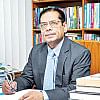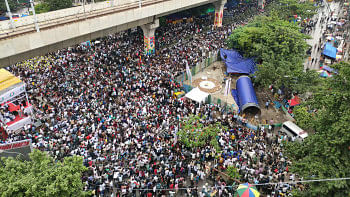Getting a grip on the Bangladesh development narrative

The celebration of 50 years of Bangladesh's independence has been a welcome opportunity to revisit and put on the spotlight Bangladesh's developmental experience over the past five decades, from a diverse range of perspectives. As is to be expected, a number of books have been published on this occasion covering the broad theme of economic development and dealing with a wide spectrum of areas. However, as the writers of the volume, Bangladesher Orthonoitik Unnoyoner Gatidhara: Subarnajayantite Firay Dekha (University Press Limited, 2022) rightly point out in the preface of the book, regrettably only a few scholars have ventured to write books in Bangla. For this, the authors—three of the most highly acclaimed economists writing on the Bangladesh economy—deserve to be particularly appreciated. And one should hasten to also add that they—Rushidan Islam Rahman, Rizwanul Islam and Quazi Shahabuddin—have penned their interpretation and assessment in such lucid and eminently readable Bangla that even readers unfamiliar with the complex concepts of economics and development studies will feel comfortable going through the volume and learning from the excellent analysis and discussion that the authors offer.
The book poses a number of questions: which factors have contributed to Bangladesh's growth? What were the drivers of the turning points in the growth? What were the trade-offs involved? What are the puzzles that call for explanation? And what are the emergent risks and challenges? Drawing on the analyses, the book then offers a number of policy suggestions in view of the journey forward.
In undertaking this task, the authors dive deep to identify which factors and policies had triggered success, where new challenges and tensions are emerging and how these will need to be addressed with appropriate policies, fit-for-purpose institutions, by stimulating and incentivising the private sector and through capacity building of labour market participants.
The arguments and analyses put forward in each of the nine chapters of the volume are based on most recent available data and evidence and survey results, the richness of analyses also lying in the extensive reference to global literature to substantiate, refute and challenge conventional explanations and draw useful conclusions.
The authors point to important transitions, from aid-dependence to trade-dependence, import-substitution to export-orientation, subsistence farming to commercial cropping and changes in the labour market, by relating these to shifts in policies and practices. This allows readers to appreciate the path that Bangladesh has crossed, with deeper understanding about the causal relationships and the associated drivers. Thus, when the authors discuss GDP growth, investment, employment generation and agricultural production and food security, they contextualise these with issues of poverty and distribution, women's participation in labour force, technological changes and human development and issues of structural transformation, and relate these to policies and actors.
The authors argue that in industry, the challenge is to encourage private sector investment by incentivising product diversification and broadening the export basket underpinned by upgradation of skills and transfer of technology. In agriculture the challenge is to raise productivity, go for crop diversification and deepen backward and forward linkage of agriculture with industry. Going forward, agriculture will need to be less dependent on weather, industry will need to be founded on a more diversified base, public sector investment will need to be cost-effective and private sector investment will need to be driven by skills and productivity, the authors argue.
While discussing issues of investment, the authors discuss why efficiency factors assume heightened interest if Bangladesh is to remain competitive both in domestic and foreign markets. This is very pertinent from the vantage point of Bangladesh's upcoming LDC graduation. They convincingly argue why not just employment creation but creating opportunities for decent employment will be increasingly important for Bangladesh; why women's greater participation has emerged as an urgent priority; why crop diversification has become a necessity for food and nutritional security at a time of shifting consumer behaviour in the backdrop of rise in purchasing power, also more so in the backdrop of the current rise in global food prices. Backed by evidence, they show why in agriculture a new technological frontier will need to be opened as the advantages of the HYV-driven technological frontier are almost exhausted. One is, however, tempted to ask if Bangladesh is poised for a Lewisian turning point.
The authors draw attention to a number of puzzles. Why did the savings rate show signs of decline at a time when poverty rates were coming down sharply? Was it because dissaving by the poor also contributed to poverty reduction? Based on global literature, the authors note why a fall in inequality has emerged as a precondition for sustainable reduction of poverty in Bangladesh. If that be the case, then the question arises as to whether in Bangladesh, where income inequality has been on the rise, the fast pace of poverty reduction will be sustainable in future. The authors do not elaborate but raise an important research question.
It is to be noted that in undertaking their analyses, the authors have been constrained by the lack of reliable and up to date data, which they go on to identify as a major weakness of Bangladesh's official statistical system. They rightly point out the importance of generating up to date data, data reliability and data integrity for sound policymaking.
Indeed, this is a very timely publication deserving attention and appreciation of both experts and general readers keen to understand the Bangladesh narrative with its shifts and turns, and how the country can sustain the current momentum and realise its developmental aspirations in the context of a fast-changing domestic scenario and dynamic global developments.
Mustafizur Rahman is Distinguished Fellow, Centre for Policy Dialogue (CPD).

 For all latest news, follow The Daily Star's Google News channel.
For all latest news, follow The Daily Star's Google News channel. 



Comments